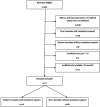Acid base and metabolic parameters of the umbilical cord blood and cerebral oxygenation immediately after birth
- PMID: 38606368
- PMCID: PMC11007157
- DOI: 10.3389/fped.2024.1385726
Acid base and metabolic parameters of the umbilical cord blood and cerebral oxygenation immediately after birth
Abstract
Objective: Aim was to investigate whether acid-base and metabolic parameters obtained from arterial umbilical cord blood affect cerebral oxygenation after birth in preterm neonates with respiratory support and in term neonates without respiratory support.
Study design: This was a post-hoc analysis of secondary outcome parameters of a prospective observational study including preterm neonates with and term neonates without respiratory support. Non-asphyxiated neonates with cerebral oxygenation measured with near-infrared spectroscopy during the first 15 min and with blood gas analyses from arterial umbilical cord blood were included. Arterial oxygen saturation (SpO2) and heart rate (HR) were monitored with pulse oximetry. Potential correlations were investigated between acid-base and metabolic parameters (pH-value, bicarbonate, base-excess, and lactate) and crSO2/cFTOE 5 min after birth.
Results: Seventy-seven neonates were included: 14 preterm neonates with respiratory support (mean gestational age [GA] 31.4 ± 4.1 weeks; mean birth weight [BW] 1,690 ± 640 g) and 63 term neonates without respiratory support (GA 38.7 ± 0.8 weeks; BW 3,258 ± 443 g). Mean crSO2 5 min after birth was 44.0% ± 24.2% in preterm and 62.2% ± 20.01% in term neonates. Mean cFTOE 5 min after birth was 0.46 ± 0.06 in preterm and 0.27 ± 0.19 in term neonates. In preterm neonates with respiratory support higher lactate was significantly associated with lower crSO2 and SpO2 and tended to be associated with higher cFTOE. In term neonates without respiratory support no significant correlations were found.
Conclusion: In non-asphyxiated preterm neonates with respiratory support, lactate levels were negatively associated with crSO2 and SpO2, whereas in term neonates without respiratory support no associations were observed.
Keywords: acid-base and metabolic parameters; cerebral oxygenation; immediate neonatal transition; near-infrared spectroscopy; neonates.
© 2024 Dusleag, Urlesberger, Schwaberger, Baik-Schneditz, Schlatzer, Wolfsberger and Pichler.
Conflict of interest statement
The authors declare that the research was conducted in the absence of any commercial or financial relationships that could be construed as a potential conflict of interest.
Figures
Similar articles
-
Acid-base and metabolic parameters and cerebral oxygenation during the immediate transition after birth-A two-center observational study.PLoS One. 2023 May 17;18(5):e0283278. doi: 10.1371/journal.pone.0283278. eCollection 2023. PLoS One. 2023. PMID: 37196035 Free PMC article.
-
Cardiac output and regional-cerebral-oxygen-saturation in preterm neonates during immediate postnatal transition: An observational study.Acta Paediatr. 2023 Jul;112(7):1404-1412. doi: 10.1111/apa.16745. Epub 2023 Mar 14. Acta Paediatr. 2023. PMID: 36880893
-
Blood Glucose and Cerebral Tissue Oxygenation Immediately after Birth-An Observational Study.J Pediatr. 2018 Sep;200:19-23. doi: 10.1016/j.jpeds.2018.05.008. Epub 2018 Jun 27. J Pediatr. 2018. PMID: 29958674
-
Cerebral oxygenation measurements during immediate neonatal transition in the delivery room: a systematic review.Pediatr Res. 2025 May 12. doi: 10.1038/s41390-025-04084-z. Online ahead of print. Pediatr Res. 2025. PMID: 40355540
-
Blood Glucose and Lactate Levels and Cerebral Oxygenation in Preterm and Term Neonates-A Systematic Qualitative Review of the Literature.Front Pediatr. 2020 Jul 29;8:361. doi: 10.3389/fped.2020.00361. eCollection 2020. Front Pediatr. 2020. PMID: 32903733 Free PMC article.
References
-
- Wyckoff MH, Aziz K, Escobedo MB, Kapadia VS, Kattwinkel J, Perlman JM. Part 13: neonatal resuscitation: 2015 American heart association guidelines update for cardiopulmonary resuscitation and emergency cardiovascular care. Circulation. (2015) 132(18 Suppl 2):S543–60. 10.1161/CIR.0000000000000252 - DOI - PubMed
LinkOut - more resources
Full Text Sources


